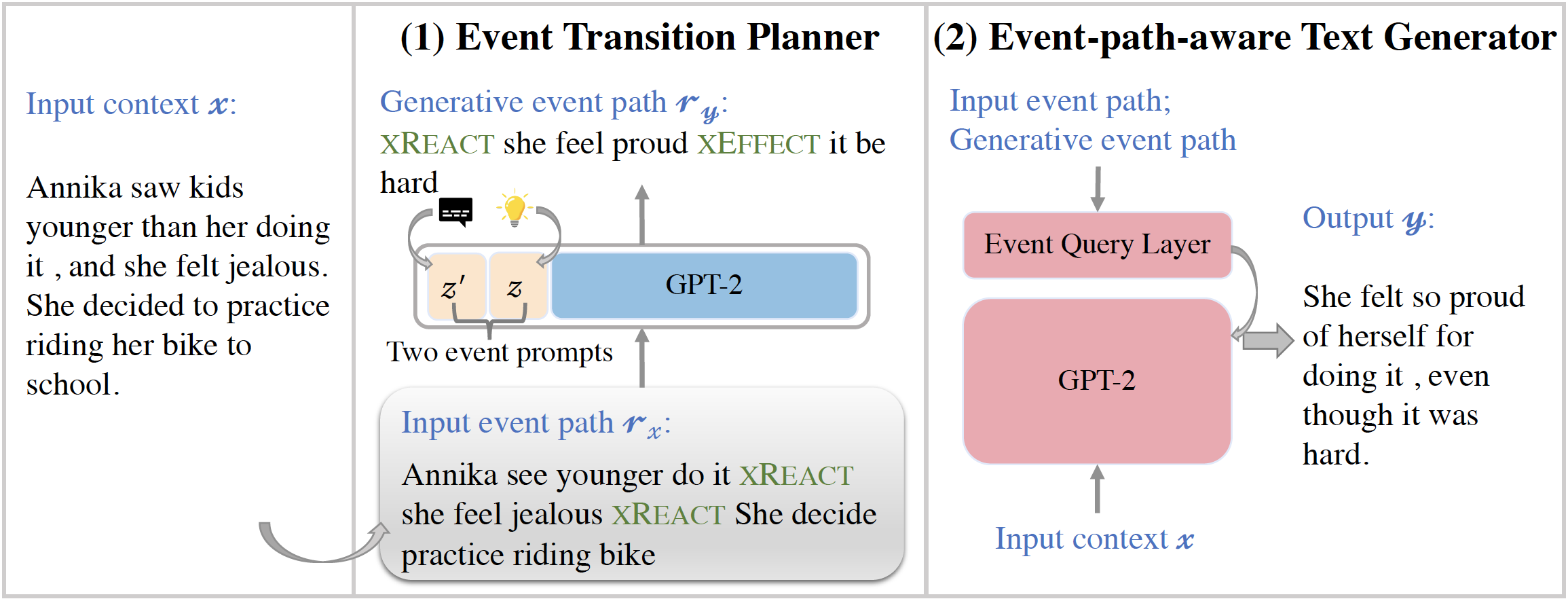This is the repository of the paper, Event Transition Planning for Open-ended Text Generation, by Qintong Li, Piji Li, Wei Bi, Zhaochun Ren, Yuxuan Lai, and Lingpeng Kong, in ACL 2022 Findings.
Make an apology 😷
The original and complete code was stored on a server, which was recycled long long ago... Succumb to Procrastination... Therefore the following code is reconstruct based on my local records. Sorry again for the late upload.
python version >= 3
torch version >= 1.4.0
transformers == 2.8.0
nltk == 3.4.5
networkx == 2.1
spacy == 2.2.1
torch-scatter == 2.0.5+${CUDA}
For torch-scatter, ${CUDA} should be replaced by either cpu, cu92, cu101 or cu102 depending on your PyTorch installation.
For more information check here.
-
External event transition source: ATOMIC.
-
Downstream datasets: ROCStories and EmpatheticDialogues.
The event transition path is defined as an alternating sequence between events and relations (we call it event transition path), where an event is a subject-verb phrase, a relation is chosen from a pre-defined label set (e.g., OREACT: object reaction; XATTR: subject attribute) of a commonsense atlas ATOMIC.
We first sample a large amount of event transition paths extracted from external source ATOMIC. To adapt each downstream task, we also collect event transition paths from the training set of each specific task.
cd code/prop_data/atomic
python preprocess.py # including six steps to process the atomic data.Collect {source: <head_event, tail_event>, target: relation} to train a BERT-based relation classifier.
python get_event_triples.pyFirst, you need install ASER, an event extraction toolkit.
git clone https://github.com/HKUST-KnowComp/ASER.git
pip install -r requirements.txt
python setup.py installAfter finishing the installation, run aser-server -n_workers 1 -n_concurrent_back_socks 10 -port 8000 -port_out 8001 -corenlp_path "YOUR_DIRECTORY/stanford-corenlp-3.9.2" -base_corenlp_port 9000.
# dialogue dataset
cd code/prop_data/empatheticdialogues
python preprocess.py "YOUR_DIRECTORY/stanford-corenlp-3.9.2" # including several steps to process the atomic data.
# story dataset
cd code/prop_data_/rocstories
python preprocess.py "YOUR_DIRECTORY/stanford-corenlp-3.9.2" # including several steps to process the atomic data.Then train a BERT classifier using event triples and relations in ATOMIC.
cd code/prop_data/event_relation_classifier
CUDA_VISIBLE_DEVICES=0 python classifier.py --mode train_test --warmup_ratio 0.1 We use the event relation classifier to complete the event transition path for downstream datasets.
# dialogue
CUDA_VISIBLE_DEVICES=0 python classifier.py --mode infer_feed_dialogue
# story
CUDA_VISIBLE_DEVICES=0 python classifier.py --mode infer_feed_storyYou could also skip the above processing steps.
The processed dataset is available at Dropbox. You could download it and put it under master directory: EventPlanforTextGen/data.
🗨️ [to be done]
mkdir -p gpt2-small wget -O pytorch_model.bin https://s3.amazonaws.com/models.huggingface.co/bert/gpt2-pytorch_model.bin wget -O vocab.json https://s3.amazonaws.com/models.huggingface.co/bert/gpt2-vocab.json wget -O merges.txt https://s3.amazonaws.com/models.huggingface.co/bert/gpt2-merges.txt wget -O config.json https://s3.amazonaws.com/models.huggingface.co/bert/gpt2-config.json
-
Data preparation
-
Training
-
Inference
-
Data preparation
-
Training
-
Inference
@inproceedings{li-etal-2021-EP4TG,
title = "Event Transition Planning for Open-ended Text Generation",
author = "Li, Qintong and Li, Piji and Bi, Wei and Ren, Zhaochun and Lai Yuxuan and Kong Lingpeng",
booktitle = "Findings of the Association for Computational Linguistics: ACL 2022",
year = "2022",
address = "Online",
publisher = "Association for Computational Linguistics",
url = "https://aclanthology.org/2022.findings-acl.269/",
pages = "https://aclanthology.org/2022.findings-acl.269/",
doi = 10.18653/v1/2022.findings-acl.269
}Please email qtleo@outlook.com if you have any questions.
